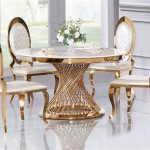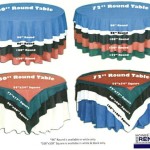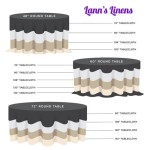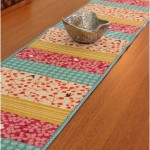Choosing the Right Dining Table Shape for a Small Space
Selecting furniture for a small space requires careful consideration of both aesthetics and functionality. A dining table, often a central piece in a home, presents a particular challenge. Its size and shape significantly impact the flow of traffic and the overall feeling of spaciousness within a room. The choice of dining table shape should therefore be driven by the room's dimensions, the number of people typically using the table, and the desired aesthetic.
Different shapes offer distinct advantages and disadvantages when maximizing space. Round, square, rectangular, and oval tables each occupy space differently, influencing how easily people can move around them. The goal is to choose a table that comfortably accommodates diners without overwhelming the room or hindering movement.
Round Tables: Maximizing Flexibility and Conversation
Round dining tables are often cited as excellent choices for small spaces. Their lack of corners can create a more intimate and inviting atmosphere, fostering conversation among diners. More importantly, the absence of sharp edges allows for easier navigation around the table. In a confined space, this can be a significant benefit, minimizing bumps and bruises as people move through the room.
A round table encourages a more fluid flow of traffic. Individuals can easily squeeze past it, even in tighter situations. This is in contrast to rectangular tables, where the sharp corners can present obstacles and impede movement, especially in narrow spaces. The rounded edges also create a softer visual impact, making the room feel less cluttered.
Round tables can also be particularly well-suited to square rooms, mirroring the room's shape and creating a sense of balance. This symmetry can contribute to a more harmonious and aesthetically pleasing overall design. However, it is crucial to select the appropriate diameter for the table. A round table that is too large will dominate the space and negate its intended benefits. Similarly, a table that is too small may not adequately serve its purpose.
Extending round tables are also available, providing additional surface area when needed. These tables typically incorporate leaves that can be added to increase the diameter, accommodating more guests. When the leaves are removed, the table reverts to its smaller, space-saving configuration. This adaptability makes round extending tables a versatile option for those who occasionally entertain but primarily require a smaller table for everyday use.
One potential drawback of round tables is their limited surface area for serving dishes. While conversation is enhanced, placing multiple serving platters can become cramped, especially with a smaller diameter table. Careful planning of serving arrangements or the use of side tables can mitigate this issue. Moreover, round tables may not be ideal for large groups, as the distance between diners can become excessive, hindering conversation.
Square Tables: A Compact and Versatile Option
Square dining tables offer a compact solution for small apartments or dining areas with limited space. They are particularly well-suited to small square rooms, creating a balanced and proportional layout. A square table can provide adequate space for two to four people, making it an ideal choice for couples or small families.
The straight lines of a square table can complement modern and minimalist design styles. Their clean, geometric shape can create a sense of order and simplicity, contributing to a less cluttered aesthetic. This can be particularly beneficial in small spaces, where visual clutter can exacerbate the feeling of confinement.
Like round tables, square tables promote intimacy and facilitate conversation. Everyone is equally positioned around the table, fostering a sense of connection and encouraging interaction. This makes square tables well-suited for intimate gatherings and meals.
While square tables offer several advantages, their fixed size can be a limitation. Unlike round extending tables, square tables are not typically expandable. This means that they may not be suitable for those who frequently entertain larger groups. However, some manufacturers offer square tables with drop-leaf extensions, providing a degree of flexibility.
The corners of a square table, while visually appealing, can pose a potential obstacle in a small space. They may impede movement and create tight corners to navigate. Therefore, careful placement of the table is crucial to ensure adequate clearance around it. Positioning the table against a wall can help maximize space by freeing up the center of the room.
When selecting a square table, consider the size of the chairs that will accompany it. Oversized chairs may overwhelm the table and further reduce the available space. Opting for smaller, more streamlined chairs can help maintain a sense of balance and proportion.
Rectangular Tables: Maximizing Seating in Narrow Spaces
Rectangular dining tables are a common choice, but they can be challenging to incorporate into small spaces. Their elongated shape can dominate a room and impede traffic flow. However, in narrow dining areas, a rectangular table can be the most efficient way to maximize seating along the length of the room.
A narrow rectangular table placed against a wall can create a banquette-style seating arrangement, freeing up floor space and maximizing seating capacity. This configuration is particularly effective in galley kitchens or long, narrow dining rooms.
When choosing a rectangular table for a small space, it is crucial to select a size that is proportional to the room. Avoid excessively long or wide tables that will overwhelm the space and create a feeling of claustrophobia. Opt for a table that is just large enough to comfortably accommodate the usual number of diners, leaving adequate space for movement around it.
Rectangular tables are often available with extending leaves, allowing them to be expanded for special occasions. This versatility can be a valuable asset in a small space, providing the option to accommodate larger groups without permanently sacrificing valuable floor space. When not in use, the leaves can be removed, and the table can be used in its smaller, more space-saving configuration.
One of the main challenges with rectangular tables in small spaces is navigating the corners. Sharp corners can pose a hazard and impede movement. To mitigate this, consider a rectangular table with rounded corners or softened edges. This will create a more forgiving silhouette and reduce the risk of bumping into the table.
The visual weight of a rectangular table can also make a room feel smaller. Choosing a table with a lighter finish or a glass top can help to minimize its visual impact. Similarly, selecting chairs with open backs can create a sense of airiness and prevent the room from feeling too crowded.
Oval Tables: A Softer Alternative to Rectangular Shapes
Oval dining tables offer a compromise between the space-saving benefits of round tables and the seating capacity of rectangular tables. Their elongated shape can accommodate more diners than a round table of similar width, while their rounded ends eliminate the sharp corners that can be problematic in small spaces.
The smooth, curved lines of an oval table create a softer and more organic aesthetic. This can be particularly appealing in contemporary or transitional design styles. The absence of harsh angles contributes to a more relaxed and inviting atmosphere, making the room feel less formal and more welcoming.
Oval tables are often a good choice for narrow dining areas, as they can be positioned against a wall without creating the same degree of obstruction as a rectangular table. The rounded ends allow for easier movement around the table, even in tight spaces.
Extending oval tables are also available, providing additional seating capacity when needed. These tables typically incorporate leaves that can be added to increase the length of the table, accommodating more guests. When the leaves are removed, the table reverts to its smaller, space-saving configuration.
One potential drawback of oval tables is their limited availability compared to other shapes. Finding the perfect size and style may require more searching and research. However, the unique benefits of an oval table can make the effort worthwhile.
When selecting an oval table, consider the placement of the chairs. Ensure that there is adequate space between the chairs and the walls or other furniture. Overcrowding the area around the table will negate its space-saving benefits and create a cramped and uncomfortable dining experience.

So What Is The Best Shape Of Dining Table For A Small Space First You Need To Round Rectangle Kitchen

The Best Dining Table Shapes Castlery Singapore

9 Small Dining Table Options For Equally Spaces According To Interior Design Experts Architectural Digest

51 Small Dining Tables To Save Space Without Sacrificing Style

13 Best Small Space Kitchen And Dining Tables Of 2024 Top Picks

Blog House Of Oak

Round Vs Rectangular Dining Table Maid2match

13 Best Small Space Kitchen And Dining Tables Of 2024 Top Picks

13 Best Small Space Kitchen And Dining Tables Of 2024 Top Picks

What Is The Best Shape Dining Table For A Small Space
Related Posts








